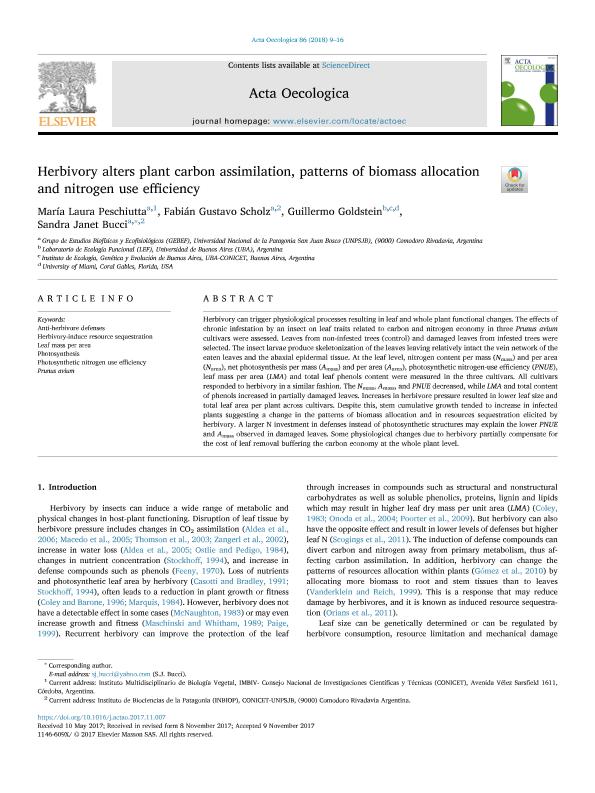Mostrar el registro sencillo del ítem
dc.contributor.author
Peschiutta, María Laura

dc.contributor.author
Scholz, Fabian Gustavo

dc.contributor.author
Goldstein, Guillermo Hernan

dc.contributor.author
Bucci, Sandra Janet

dc.date.available
2019-10-17T20:53:33Z
dc.date.issued
2018-01
dc.identifier.citation
Peschiutta, María Laura; Scholz, Fabian Gustavo; Goldstein, Guillermo Hernan; Bucci, Sandra Janet; Herbivory alters plant carbon assimilation, patterns of biomass allocation and nitrogen use efficiency; Elsevier Masson; Acta Oecologica; 86; 1-2018; 9-16
dc.identifier.issn
1146-609X
dc.identifier.uri
http://hdl.handle.net/11336/86217
dc.description.abstract
Herbivory can trigger physiological processes resulting in leaf and whole plant functional changes. The effects of chronic infestation by an insect on leaf traits related to carbon and nitrogen economy in three Prunus avium cultivars were assessed. Leaves from non-infested trees (control) and damaged leaves from infested trees were selected. The insect larvae produce skeletonization of the leaves leaving relatively intact the vein network of the eaten leaves and the abaxial epidermal tissue. At the leaf level, nitrogen content per mass (Nmass) and per area (Narea), net photosynthesis per mass (Amass) and per area (Aarea), photosynthetic nitrogen-use efficiency (PNUE), leaf mass per area (LMA) and total leaf phenols content were measured in the three cultivars. All cultivars responded to herbivory in a similar fashion. The Nmass, Amass, and PNUE decreased, while LMA and total content of phenols increased in partially damaged leaves. Increases in herbivore pressure resulted in lower leaf size and total leaf area per plant across cultivars. Despite this, stem cumulative growth tended to increase in infected plants suggesting a change in the patterns of biomass allocation and in resources sequestration elicited by herbivory. A larger N investment in defenses instead of photosynthetic structures may explain the lower PNUE and Amass observed in damaged leaves. Some physiological changes due to herbivory partially compensate for the cost of leaf removal buffering the carbon economy at the whole plant level.
dc.format
application/pdf
dc.language.iso
eng
dc.publisher
Elsevier Masson

dc.rights
info:eu-repo/semantics/openAccess
dc.rights.uri
https://creativecommons.org/licenses/by-nc-nd/2.5/ar/
dc.subject
ANTI-HERBIVORE DEFENSES
dc.subject
HERBIVORY-INDUCE RESOURCE SEQUESTRATION
dc.subject
LEAF MASS PER AREA
dc.subject
PHOTOSYNTHESIS
dc.subject
PHOTOSYNTHETIC NITROGEN USE EFFICIENCY
dc.subject
PRUNUS AVIUM
dc.subject.classification
Ciencias de las Plantas, Botánica

dc.subject.classification
Ciencias Biológicas

dc.subject.classification
CIENCIAS NATURALES Y EXACTAS

dc.title
Herbivory alters plant carbon assimilation, patterns of biomass allocation and nitrogen use efficiency
dc.type
info:eu-repo/semantics/article
dc.type
info:ar-repo/semantics/artículo
dc.type
info:eu-repo/semantics/publishedVersion
dc.date.updated
2019-10-15T13:13:02Z
dc.journal.volume
86
dc.journal.pagination
9-16
dc.journal.pais
Francia

dc.journal.ciudad
Paris
dc.description.fil
Fil: Peschiutta, María Laura. Consejo Nacional de Investigaciones Científicas y Técnicas; Argentina. Universidad Nacional de la Patagonia "San Juan Bosco"; Argentina
dc.description.fil
Fil: Scholz, Fabian Gustavo. Consejo Nacional de Investigaciones Científicas y Técnicas; Argentina. Universidad Nacional de la Patagonia "San Juan Bosco"; Argentina
dc.description.fil
Fil: Goldstein, Guillermo Hernan. Consejo Nacional de Investigaciones Científicas y Técnicas; Argentina. Universidad de Buenos Aires; Argentina. University of Miami; Estados Unidos
dc.description.fil
Fil: Bucci, Sandra Janet. Consejo Nacional de Investigaciones Científicas y Técnicas; Argentina. Universidad Nacional de la Patagonia "San Juan Bosco"; Argentina
dc.journal.title
Acta Oecologica

dc.relation.alternativeid
info:eu-repo/semantics/altIdentifier/doi/https://doi.org/10.1016/j.actao.2017.11.007
dc.relation.alternativeid
info:eu-repo/semantics/altIdentifier/url/https://www.sciencedirect.com/science/article/pii/S1146609X17301972
Archivos asociados
